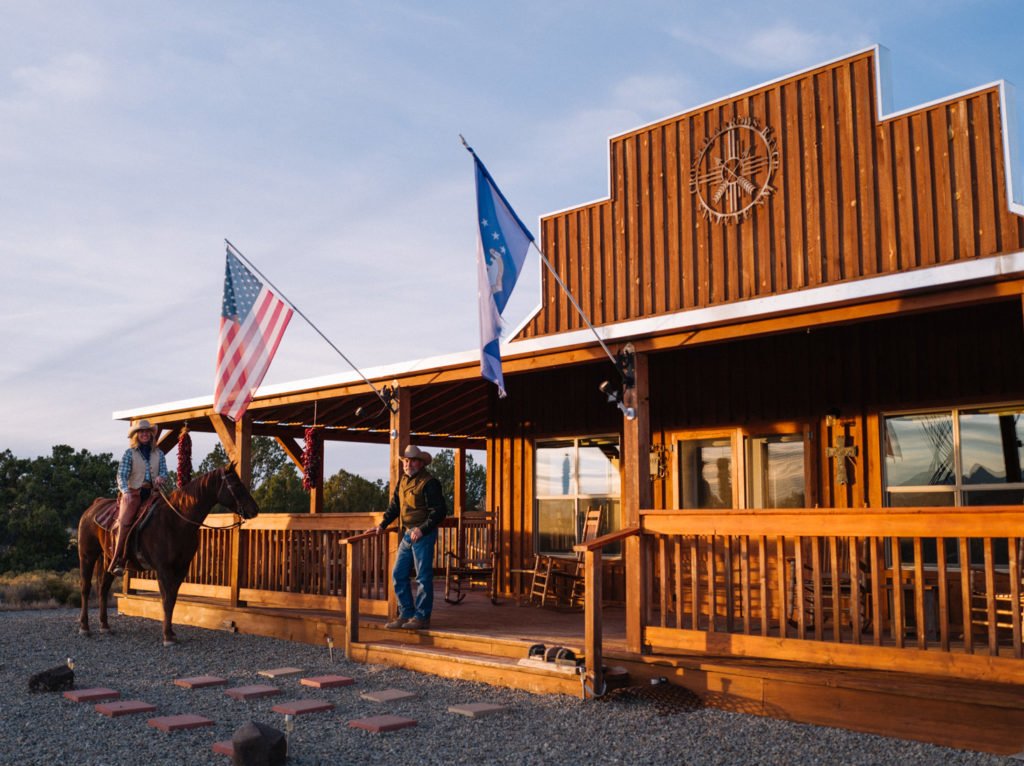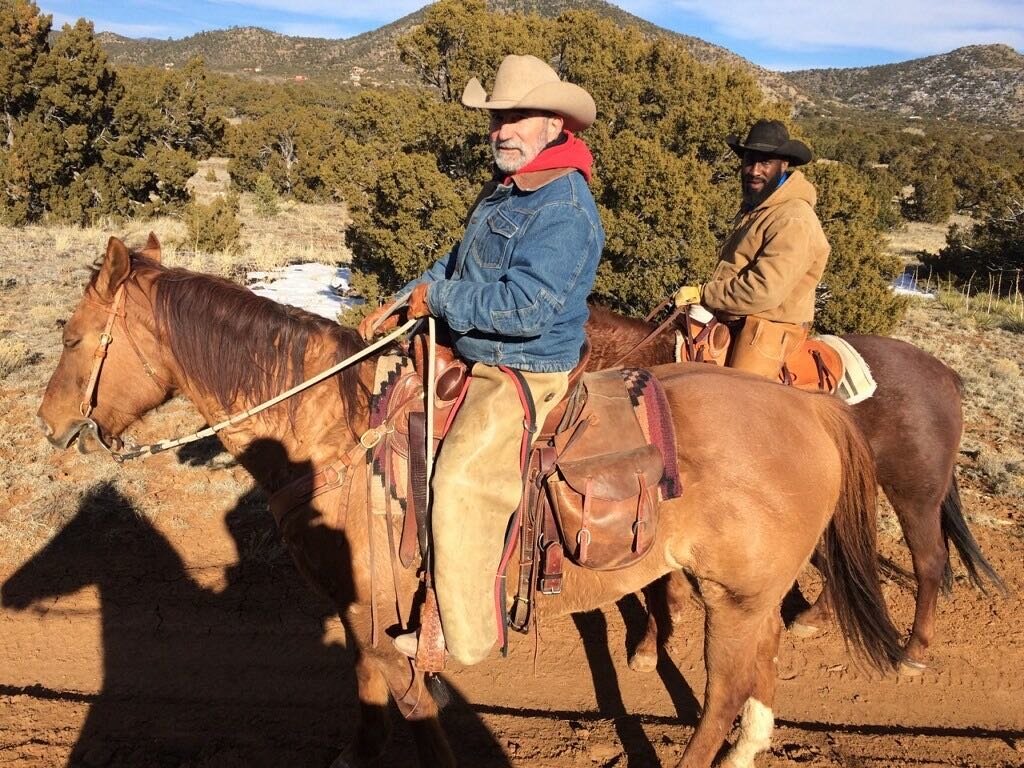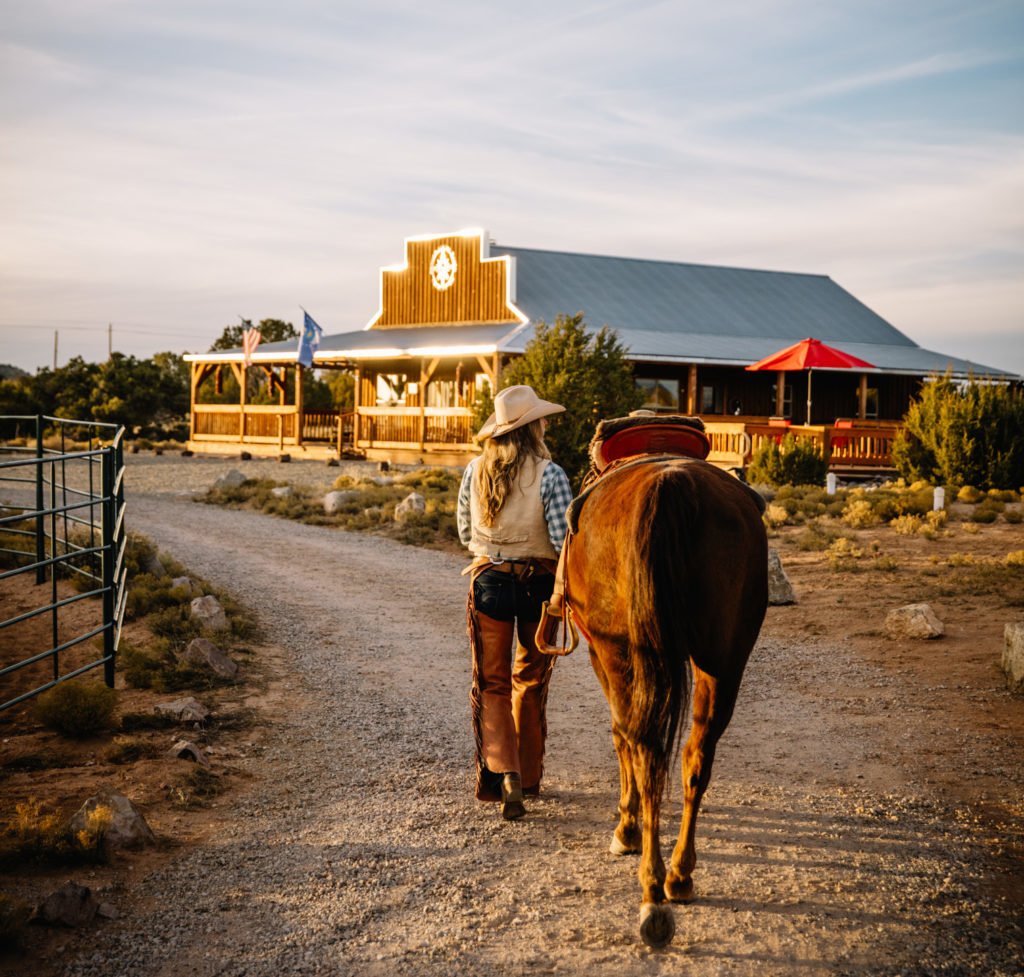
Horses for Heroes
Rancher Rick Iannucci is an ordained minister and police chaplin as well as a retired U.S. Marshal and former Green Beret. In 2008, Iannucci and his wife, Nancy DeSantis, were running a ranch rodeo club for 4H children, including their daughter, at their Crossed Arrows Ranch in Santa Fe, New Mexico.
Around that time, Iannucci got a phone call from a friend who was experienced with horse therapy for special needs children. She had learned about some military service members who had returned from Afghanistan in pretty rough shape, and she thought Iannucci and DeSantis were better equipped to help than she was. “You’re the only ex-Green-Beret-cowboy I know,” she said. “Can you help?” Little did Iannucci know that the experience would turn into a spiritual calling and eventually lead to a new 501(c)(3) nonprofit business named Horses for Heroes.
When Iannucci and DeSantis began introducing veterans to horses, there were still plenty of 4H children on the ranch. “For a few years on the front end,” Iannucci recalled, “we had the kids working with the veterans and the veterans working with the kids. The vets were even our lane graders for the ranch rodeo […]. We had such a great time.”

However, as their daughter and her friends got older and transitioned out of 4H, Horses for Heroes became their sole focus. The nonprofit became official, and their focus shifted to post-9/11 veterans and active military personnel.
Horses might seem like intimidating creatures to those who haven’t spent much time around them. However, the bond between horses and humans is legendary. Former British Prime Minister Winston Churchill once said: “There is something about the outside of a horse that is good for the inside of a man.” Perhaps guided by this wisdom, the Horses for Heroes Cowboy Up! program uses horses to teach soldiers how to cope with anxiety, live in the moment, find a sense of inner peace, and even build relationships.
While Horses for Heroes is not the only organization to discover the benefits of pairing veterans with animals in the great outdoors, Iannucci and DeSantis take a different approach to this type of therapy. It starts with a rather unique definition of PTSD. While the clinical community spells out the acronym as “post-traumatic stress disorder,” Horses for Heroes prefers to think of it as “post-traumatic spiritual dissonance.”

“Nobody likes the word ‘disorder,’” DeSantis said in a recent interview with Santa Fe Public Radio station KSFR. “There is also no one-size-fits-all [explanation] for PTSD […]. By talking with our veterans, we saw they were actually [inflicted with] soul wounds […]. We don’t look at it through the lense of mental illness because [PTSD is] not a disease. Pain is not pathology. That’s why we call it ‘post-traumatic spiritual dissonance.’”
They also take care not to include the word “therapy” in any of the Horses for Heroes programs. “We don’t like to call what we do ‘horse therapy,’” he said. “Technically, yes, it’s therapeutic. But not calling it ‘therapy’ is us steering away from what causes veterans to cringe. The guys hate [the word ‘therapy’] because they associate it being treated like little kids — and here’s a guy with four combat tours under his belt who has been blown up several times. Fifty-five minutes on a horse, and ‘we’ll see you next week, Timmy’ doesn’t work. He doesn’t want to be coddled. We have our own modality — we call it ‘skill set restructuring.’”
Instead of telling the injured or disabled warrior to ignore the past and begin anew, skill set restructuring encourages clients to remember what they did and how they did it, then apply those same skills to ranching and American horsemanship as a secondary template. This approach respects the warrior and helps them rewrite the narrative for a new mission.

The length of stay for Horses for Heroes participants depends upon their unique circumstances, such as family dynamics, employment, etc. Iannucci said he strongly encourages a minimum one-week commitment, but 10 days is not uncommon. Stays can even be extended beyond that if necessary. Iannucci has even been known to contact employers on behalf of the attendees to negotiate more time away. Since Horses for Heroes owns the property and bunkhouses, it’s usually a simple matter to respond to changing circumstances. The organization makes every effort to meet people where they are in life and tailor the experience to them.
At the ranch, days typically begin with DeSantis leading a highly specialized yoga routine, which is designed to target the muscle groups used for riding horses. The history of the yoga program is a story unto itself. DeSantis co-developed the exercises with Beryl Bender-Birch, author of “Yoga for Warriors,” a book written while working with civilians and first responders in the aftermath of the 9/11 attacks. Birch has been a staunch supporter of Horses for Heroes and its programs.
From there, it’s off to the round pen. This circular, fenced-in enclosure is traditionally used to train horses. However, at Horses for Heroes, the round pen is an environment where the veterans learn as much as the horses do. As early as 600 BC, humans recognized that horses can be great teachers. They perceive, interpret, and respond to where we are at in the present moment in time. “When the guys go into the round pen, we put the horses at liberty (without halters),” Iannucci said. “We watch how they interact with each other. The horse knows! ‘Are you BSing me or not, dude?’” The idea is to build comfort and trust between horse and human, which paves the path for saddling up later in the week.

While his ranchers-in-training are finishing up in the pen, Iannucci hands the reins over to his cadre and excuses himself to prepare a hot, cowboy-style lunch. Before serving the food family style, Iannucci and his crew say a blessing. The object of the prayer isn’t to proselytize but to re-ground and center the attendees, remind them to be grateful about being alive, and mitigate negative thoughts.
The agenda for most afternoons is left intentionally vague to account for seasonal activities at the ranch and its surrounding properties — cattle movement, roping, and branding to name a few. Sometimes these opportunities present themselves with little advance notice. However, the camaraderie, cowboy-up mentality, and ever-changing missions have similarities to the military lifestyle. “If something changes, you don’t come unglued,” Iannucci said. “You improvise. You adapt. You overcome!”
But the Horse for Heroes experience is not just about “whoopin’ and spurin’.” It’s also about developing life skills for the civilian world. DeSantis spends time discussing important topics such as brain function, nutrition, self-regulation, and other “multitools” for resilience. Among other things, Iannucci teaches food preparation and cooking. When appropriate, he administers pastoral care. When the new cowboys and cowgirls leave the ranch, they are equipped with the knowledge required to tap a vast network of self-help resources and create a new “business plan” for running their lives, Iannucci said.
Do any Cowboy Up! participants walk away from the program because it’s not their cup of tea? Iannucci hasn’t seen that yet. “We are not a cookie cutter operation,” he said. “In other words, we listen to the people and adapt as necessary. For example, I might get guys who aren’t crazy about riding, but they still enjoy working with the horses. There’s really something here for everyone.”

To gauge the success of the Horses for Heroes approach, one only needs to browse the long list of endorsements and testimonials at their website. It’s also worth noting that Cowboy Up! has caught the attention of Israeli Defense Force (IDF). Iannucci and DeSantis were recently invited to Israel to discuss the program. As a direct result of that trip, the Crossed Arrows Ranch hosted and trained its first IDF veteran, who will be spearheading a version of the program in Israel. The Israeli program will accommodate IDF soldiers transitioning out of service in the Global War on Terrorism.
While Cowboy Up! serves wounded and disabled honorably discharged post-9/11 veterans, Horses for Heroes has added a few new offerings that cater to other demographics in the military community:
- Resilient Warriors is designed for the 80 percent of veterans who are not on disability but are dealing with other issues common to post-military transition
- Resilient Families is a program that allows Horses for Heroes clients to return with their families for a directed or self-guided retreat
- Pre-deployment Resiliency Training is a one-week program intended for members of the active military, National Guard, and Reserves who are facing the rigors and anxiety associated with the unknowns of deployment
Horse for Heroes does not consider itself a rehabilitation facility — participants are expected to have transcended their addictions prior to completing an application. Due to the nature of horseback riding and ranch activities, applicants must be ambulatory (to sit in the saddle) and weigh less than 200 pounds (to protect the horses). In some cases, depending upon prior diagnoses, applicants may also be asked to include certain VA paperwork. For those who qualify, there is virtually no out-of-pocket expense. Horses for Heroes is fully supported by private donations.

Tim Cooper is a contributing writer for Coffee or Die and has been a freelance writer for more than 20 years. He is also a certified firearms instructor and soon-to-be-famous recording artist with Fat Chance Records. When Tim is not traveling the world on assignment, which is actually more often than not, you will probably find him at a nearby shooting range or sitting behind a drum kit, staring at his bandmates in bewilderment.
BRCC and Bad Moon Print Press team up for an exclusive, limited-edition T-shirt design!
BRCC partners with Team Room Design for an exclusive T-shirt release!
Thirty Seconds Out has partnered with BRCC for an exclusive shirt design invoking the God of Winter.
Lucas O'Hara of Grizzly Forge has teamed up with BRCC for a badass, exclusive Shirt Club T-shirt design featuring his most popular knife and tiomahawk.
Coffee or Die sits down with one of the graphic designers behind Black Rifle Coffee's signature look and vibe.
Biden will award the Medal of Honor to a Vietnam War Army helicopter pilot who risked his life to save a reconnaissance team from almost certain death.
Ever wonder how much Jack Mandaville would f*ck sh*t up if he went back in time? The American Revolution didn't even see him coming.
A nearly 200-year-old West Point time capsule that at first appeared to yield little more than dust contains hidden treasure, the US Military Academy said.












